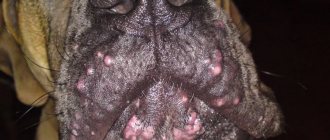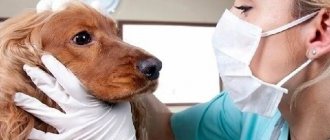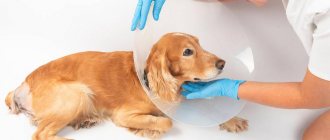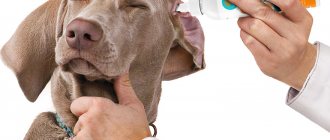Acanthosis nigricans in dogs is a skin disease in which the animal experiences increased accumulation and production of melanin, baldness of the affected area where pigmentation is observed, and thickening of the epidermis. The violation is caused by several reasons. Treatment of a dermatological disease is carried out under the supervision of a veterinarian, and the factor that triggers acanthosis is necessarily eliminated.
Typical location of acanthosis nigricans in the armpit
Characteristics of acanthosis nigricans
Acanthosis nigricans is a dermatological disease. Associated with dysfunction of the sebaceous glands. It manifests itself as a change in healthy skin to localized dark, rough folds, between which papillomas develop. The main places of damage: axillary area, neck, groin area, abdomen. Small spots and dots may appear in these places. If left untreated, the disease affects the entire body of the animal.
Acanthosis nigricans in a dachshund
Why does acanthosis occur?
The appearance of black spots on an animal’s body can be associated with a number of factors:
- unbalanced diet, in which owners mix natural food and dry food;
- unfavorable environmental conditions. It is no secret that during walks, dogs' skin is exposed to reagents that can cause the development of dermatitis in winter or photodermatosis when exposed to sunlight in summer;
- sedentary lifestyle. Lack of physical activity and poor diet can cause metabolic disorders in the animal, which can be accompanied by increased pigmentation, acne and itchy skin;
- breed predisposition;
- lentigo is a skin lesion that is more cosmetic in nature and has no treatment;
- Dermatophytosis is a fungal disease, a sign of which is dark spots on the body of the animal. The surface of the spots may peel off, become covered with crusts and scabs. The disease is accompanied by severe skin itching;
- Weeping dermatitis, in which dark spots form when the dog constantly scratches the lesions.
Since there are many causes of the disease, you should seek advice from a specialist who will correctly diagnose the disease and prescribe treatment.
Causes of occurrence on the skin
The disease has three types, which determine the causes:
Primary
Affects dachshund dogs. The disease usually begins to develop at an early age.
Causes:
- hereditary factor;
- endocrinological diseases;
- kidney disease.
Secondary black
Develops predominantly in smooth-haired dog breeds.
Causes:
- neoplasms of various origins (benign and malignant);
- diseases of internal organs and systems;
- dysfunction of the genitourinary system;
- thyroid diseases;
- staphylococcal infection;
- chronic stress;
- overweight;
- poor environmental living conditions.
Pseudoacanthosis
Has similar symptoms. It is a skin rash (chronic or temporary), similar to skin changes like acanthosis.
Causes:
- allergy;
- dermatitis of various origins;
- hormonal imbalances;
- overweight.
In the localized area, the fur completely falls out, and an unpleasant odor begins to emanate from the pet.
What complications may there be?
Despite the fact that with timely treatment, acanthosis nigricans can be cured or its spread can be stopped, if the owner does not contact a veterinary clinic in a timely manner, the pet may develop a number of complications.
What could be:
- Formation of deep ulcers and abscesses. Occurs when the animal is restless, scratching spots and infection gets into the wounds.
- Baldness, roughening of the skin over large areas of the body.
- The appearance of other problems with the dermis, which aggravate the course of the underlying disease.
- Possible development of oncological processes in the dermis, both benign and malignant.
- Blood poisoning (septic phenomena) due to infection in the wounds. In this case, the lack of urgent veterinary care leads to death.
If the dog is constantly worried, the spots cause her discomfort, this affects her quality of life, the appearance of anorexia (refusal to feed), and weight loss. Complete apathy or, conversely, aggression cannot be ruled out.
Symptoms of the disease in a dog
The main symptom of the disease is damage to the skin.
The process occurs in several stages:
- At the initial stage, the skin darkens and becomes rough. Does not cause discomfort to the pet. Primary acanthosis ends at this stage.
- Next, the skin becomes rougher, forming a fairly hard crust, almost black in color. Rough skin is formed by folds, between which growths of different sizes form. The hair in this area becomes damaged and falls out due to constant brushing. Bald patches form.
- The next stage is infection of the damaged areas. This creates a characteristic unpleasant odor. The inflamed areas are painful and cause significant discomfort to the dog.
The second and third stages of the development of acanthosis nigricans are characteristic only of secondary acanthosis nigricans.
Another symptom at these stages is itching and the dog scratching the affected areas.
When acanthosis nigricans in dogs tends to progress, more aggressive therapy must be resorted to
Atopic dermatitis
The appearance of black spots on a dog's body may be evidence of the development of atopic dermatitis. The pathology occurs as a result of a genetic malfunction and is an allergic reaction. In addition to black spots on the skin, a dog with atopic dermatitis will develop other symptoms:
- severe itching;
- animal anxiety;
- scratching the skin until it bleeds.
Atopic dermatitis is diagnosed more often in pets at a young age, starting from 8 months. There are a number of dog breeds, such as Pugs, Yorkies, German Shepherds and Labradors, in which atopic dermatitis occurs many times more often than in other dogs.
Atopy can be seasonal and associated with the arrival of warmer months. Flowering trees and grasses lead to the accumulation of pollen in the air. In addition, during the warm season, parasites, such as house dust mites and pathogenic fungi, become more active.
Diagnosis of small dark spots (dots)
All diagnostic research occurs in several stages:
Features of pathology and description
It is believed that the disease is based on genodermatosis, in which excessive hyperpigmentation occurs. But acanthosis of secondary origin is much more common, but its causes have not yet been established, although the study of this issue continues. The disease is considered a type of anti-inflammatory hyperpigmentation.
Causes of acanthosis nigricans may include:
- Inflammatory reactions in the most delicate groin and axillary areas.
- Endocrine diseases, incl. hypothyroidism, hypersecretion of corticosteroids.
- Obesity, when a dog’s weight is diagnosed above normal and as a critical body mass.
- Nutritional allergies due to improper feeding.
- Infections of the upper layers of the dermis.
Important! Contrary to popular belief among owners, acanthosis nigricans is not contagious. It is not transmitted from animal to animal, much less to humans. Another thing is that a dog with damage to the dermis does not look the best, so at the first signs of acanthosis you need to urgently contact a veterinary clinic.
Treatment of the disease
A complete cure for primary acanthosis is impossible.
Therapy methods are aimed at reducing the unpleasant manifestations of the disease to a minimum.
In this case, hormonal drugs and local remedies are prescribed.
If the dog is not bothered by the manifestations of the disease (there is no itching or inflammation), i.e. The problem is purely cosmetic; no therapy is prescribed.
In case of secondary maintenance therapy consists of:
Primary pathology, which is caused by genetic origin, cannot be completely cured
Lentigo
Black spots on the skin may be a cosmetic defect such as lentigines. There is no effective therapy for this form of pathology. Lentigo can be localized in the dog’s abdomen or limbs. Less commonly, a cosmetic defect is diagnosed in other areas of the animal’s body.
Most often, lentigo appears in middle-aged and elderly dogs.
The small dark spots that appear begin to gradually increase in size over several months. Not only does the size of the spots grow, but their number also increases. After a certain period (for each animal individually), the growth of spots stops.
From the outside, lentigines look like flat, well-defined spots that do not protrude above the surface of the skin. True lentigo in a dog does not itch, does not provoke itching, and the surface of the spot is smooth. If the black spot has a lumpy structure or thickenings are present, it is recommended to immediately contact a veterinary clinic for advice and an accurate diagnosis.
Consequences of the disease and complications
Complications and consequences of the disease occur in the absence of timely correct treatment or incorrect therapy.
Treatment must be prescribed by a veterinarian. Self-prescribing medications to a dog is unacceptable.
Illiterate use of pharmaceuticals can aggravate the situation, and a large number of side effects can worsen the pet’s health.
It is impossible to completely cure, but if you do not fight the symptoms, the likelihood of inflammatory foci occurring is 100%.
Injured, cracked skin is a favorable substrate for the development of bacteria and fungi. Which in turn leads to complex infectious diseases that affect the entire body of the animal. Further, if there is no treatment, the pet dies.
Why is it worth getting treatment from a veterinarian?
Many diseases require constant monitoring by specialists. Acanthosis is no exception. It is in our veterinary that the most qualified doctors who have extensive experience working with a wide variety of patients will help your sick pet. Only in our veterinary center there are highly specialized specialists who are ready to help your pet. This is where you can check your thyroid gland and get advice from a professional endocrinologist and have your blood checked. Also, if the doctor prescribes it, you can have your stool tested.
- What specialists will help prevent acanthosis from developing?
- Qualified veterinarian;
- nephrologist;
- dermatologist;
- a laboratory technician who will help you get the tests done in a timely manner and give you the transcript.
This will help to properly treat the disease, because a disease such as acanthosis requires the vigilant attention of a caring owner. The veterinarian, where you are encouraged to seek help, is an excellent solution for the treatment of any complex disease.
So, for a test and a simple examination of the animal, you can call a veterinarian at home. The specialist will show you all the necessary documents. If you work late and don’t have time to travel to the veterinary center, then calling a doctor at home will certainly be a good solution.
What are the benefits of veterinary
Currently, there are a large number of clinics and veterinary centers, of which an insane number have opened.
- But why should you choose us “YA-VET”?
- Firstly, we have the opportunity to carry out most of the necessary procedures at home;
- there is a staff of narrow specialists who will help on all issues of concern at any time;
- neat nurses who will kindly and gently take your pet’s test;
- the most modern laboratory will give the most reliable answer;
- We work at any time, you can ask for help even at 4 am if necessary.
We also have something that many doctors and veterinary clinics do not have - friendliness and a welcoming atmosphere. Sometimes this also plays a significant role. Remember that dachshunds perfectly sense the mood of others and the optimistic mood of the owner is especially important for them.
Caring for a sick dog
Features of caring for a sick dog are related to alleviating the pet’s condition and maintaining sanitary conditions in the animal’s place of residence.
It is necessary to carry out all medical procedures strictly as prescribed by the veterinarian: treat damaged skin, wash the animal.
Carefully ensure that the dog does not scratch the affected areas (give sedatives and antihistamines in a timely manner).
Maintaining cleanliness in the area where the dog lives is necessary to prevent infection of the injured skin.
Antimicrobial shampoo will help with inflammation
Breeds susceptible to pigmentation or coat color changes
No dog breed is immune from manifestations of pigmentation, especially in adulthood.
But there are breeds in which genetic abnormalities were monitored and their course was monitored - these are pugs (lentigines) and dachshunds (acantosis nigricans).
A tendency to lentigo has been noted in dwarf schnauzers and sharpeis.
German Shepherds are prone to acquired pigmentation. These are bacterial infections affecting the snout and lupus vulgaris.
Scottish Shepherds are predisposed to lupus vulgaris, which also affects the animal's face.
Chow chow and Akita Inu are predisposed to an acquired autoimmune disease that affects the skin with inflammatory purulent discharge.
Loss of pigmentation in the area of the nose and lips is caused by inflammation of the front part of the eye in breeds such as Akita Inu, Samoyeds and Siberian Huskies.
Doberman Pinschers, Rottweilers, Siberian Huskies, Alaskan Malamutes and Labrador Retrievers are prone to depigmentation (coloring the coat white).
Poodle, Yorkshire, Silky and Bedlington terriers, Old English Sheepdog are breeds that, due to a malfunction of the sebaceous glands or during the recovery period after an illness, may experience a change in coat color.
Forms
Pathology has 2 forms:
- Primary . Another name for it is genodermatosis (a skin disease that is genetically determined). A huge number of dog breeds suffer from this disease, but dachshunds are most susceptible to it. They develop all the characteristic signs of acanthosis nigricans before they are one year old.
- Secondary . It is called post-inflammatory hyperpigmentation. This disease occurs in almost all breeds; age in this case does not matter. Post-inflammatory hyperpigmentation occurs against the background of diseases that are accompanied by inflammatory processes located in the groin or axillary region, obesity, and endocrinopathy.
Many people believe that acanthosis nigricans is contagious. However, in fact, they are deeply mistaken, since this disease is genetically determined, that is, specific: it cannot pass from one sick dog to another healthy one.
Main symptoms
The development of pigmentation can be sluggish or, conversely, with rapid development, depending on the symptoms that cause it.
Signs of genetic pigmentation can include:
- single or groups of dark spots on the dog’s stomach, limbs, body, as well as on the eyelids and oral mucosa;
- pigmentation in the armpits and groin without signs of inflammation.
Signs of acquired pigmentation and ongoing inflammatory processes are:
- oddly shaped spots that change in size from small to noticeable changes in skin color;
- inflamed dark or red spots;
- the spots become thicker, itchy, and the skin becomes smoother;
- irritation due to friction in the armpits;
- depigmentation or pigmentation of the pet’s nose;
- Changes in coat color, for example, infectious pathogens cause light coats to turn rusty brown.
General symptoms
Regardless of the type of disease, the clinical picture will be approximately the same. Initially, there is a barely noticeable darkening of the skin in the intergluteal region, on the abdomen, ears and inside the folds (head, limbs). Over time, the affected areas become more visible, standing out as black against the background of light skin.
Next, the skin changes density, becoming rough and hard to the touch. Growths of heterogeneous shapes appear in the folds. Sometimes this deformation is accompanied by a characteristic putrefactive odor. In parallel, alopecia may develop - gradual or, conversely, rapid hair loss in problem areas. The dog becomes restless, itches endlessly, does not allow darkened areas to be touched, and whines from pain and itching.
Skin infections
Skin infections may occur on their own or may be secondary to an allergy. Regardless of the cause, if there has been an infection, it can lead to hyperpigmentation. Bacterial infections are the most common causes of skin infections.
- Mange (demodex, sarcoptic mange) can cause darkening. Demodex lesions are usually local.
- Sarcoptus usually becomes generalized. The discoloration may go away after scabies is treated, but it will remain after severe cases.
- Ringworm (dermatophytosis) can also cause temporary or permanent hyperpigmentation.
Veterinarians will ask the following questions:
- Why is the belly red or black?
- Where did the itching come from? How bad does it itch?
- Is there a foreign smell?
- Does it only itch at certain times of the year? (Allergy?)
The study is carried out by analyzing the medical history and diagnostics, for example, scraping, cytology, biopsy. If you adopt a dog that is healthy, not itchy anywhere, but has obvious dark areas, he probably suffered from illnesses such as allergies when he was little.











